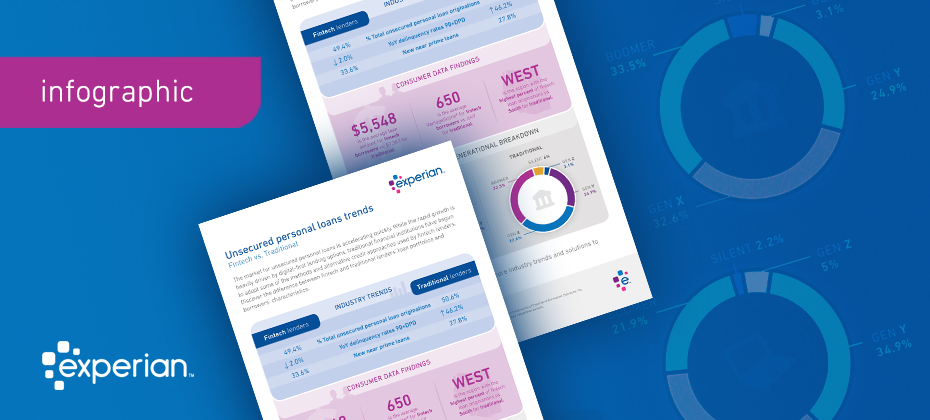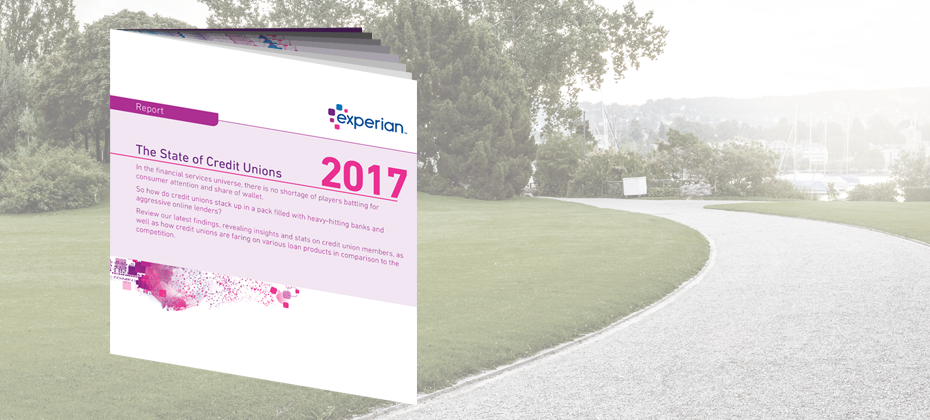Tag: personal loans

In the dynamic consumer credit landscape, understanding emerging trends is paramount for fintechs to thrive. Experian's latest fintech trends report provides deep insights into the evolving market, shedding light on crucial areas such as origination volumes, average loan balances, and delinquency trends. Let's delve into some key findings and their implications for fintech lenders. Fintech lending origination volume trends The report reveals intriguing shifts in origination volumes for unsecured personal loans and credit cards. While overall origination amounts dipped, fintechs experienced a notable decrease, signaling potential challenges in funding availability and economic uncertainties. Despite this, the total origination volume for fintechs remains robust, underlining their continued significance in the market. Fintech market share versus traditional lenders Fintechs, known for their agility and digital prowess, witnessed fluctuations in market share, particularly in the unsecured personal loan segment. While digital loans continue to drive a significant portion of originations, there's a discernible shift in market dynamics, urging fintech lenders to explore diversification strategies, including expanding into credit card offerings. Fintech lending average loan balance trends Amidst changing economic landscapes, average loan balances for both unsecured personal loans and credit cards exhibited intriguing patterns. Fintech lenders, although maintaining a competitive edge in average balances, face the challenge of balancing risk and profitability, especially amidst rising delinquency levels. Fintech lending delinquency trends One of the most critical aspects highlighted in the report is the uptick in delinquency levels for unsecured personal loans and credit cards. While fintechs navigate through economic uncertainties, there's a growing imperative to enhance risk management strategies and focus on prime and above credit tiers to mitigate potential risks. Understanding the digital borrower As digital borrowing continues to gain prominence, it's essential for fintechs to grasp the nuances of the digital borrower. With millennials emerging as key players in the digital lending landscape, fintechs must tailor their offerings to cater to the unique preferences and behaviors of this demographic segment. Looking ahead to 2024 for fintech lenders As we look to the future, data-driven decision-making and strategic portfolio management are more important than ever for fintechs. With economic uncertainties still in the mix, fintechs must leverage data and analytics to fuel growth while safeguarding against potential risks. Experian's fintech trends report serves as a guiding beacon, equipping fintechs with the knowledge and strategies needed to navigate through uncertainties and unlock opportunities for sustainable growth. The report offers actionable insights, including the imperative to conduct periodic portfolio reviews, retool data analytics and models, and remodel lending criteria to stay ahead in the competitive landscape. Learn more about our fintech solutions and how we can work together to drive profitable growth for your company. Learn more Download the report About the report: Experian's Fintech Trends Report 2024 offers a comprehensive analysis of credit trends, leveraging data from January 2019 to November 2023. The report provides valuable insights into the evolving landscape of unsecured personal loans and credit cards, empowering fintechs with actionable intelligence to thrive in a competitive market environment.

As industry experts are still unsure when the economy will fully recover, re-entry into marketing preapproved credit offers seems like a far-off proposal. However, several of the top credit card issuers are already mailing prescreen offers, with many other lenders following suit. When the time comes for organizations to resume, or even expand this type of targeting, odds are that the marketing budget will be tighter than in the past. To make the most of the limited available marketing spend, lenders will need to be more prescriptive with their selection process to increase response rates on fewer delivered offers. Choosing the best candidates to receive these offers, from a credit risk perspective, will be critical. With delinquencies being suppressed due to CARES Act reporting guidelines, identifying consumers with the ability to repay will require additional assessment of recent credit behavior metrics, such as actual payment amounts and balance migration. Along with the presence of explicit indicators of accommodated trades (trades affected by natural disaster, trades with a balance but no scheduled payment amount) on a prospect’s credit file, their recent trends in payments and balance shifts can be integral in determining whether a prospect has been adversely impacted by today’s economic environment. Once risk criteria have been developed using a mix of bureau scores (like the VantageScore® credit score), traditional credit attributes and trended attributes measuring recent activity, additional targeting will be critical for selecting a population that’s most likely to open the relevant trade type. For credit cards and personal installment loans, response performance can be greatly improved by aligning product offers with prospects based on their propensity to revolve, pay in full each month or consolidate balances. Additionally, the process to select final prospects should integrate a propensity to open/respond assessment for the specific offering. While many lenders have custom models developed on previous internal response performance, off-the-shelf propensity to open models are also available to provide an assessment of a prospect’s likelihood to open a particular type of trade in the coming months. These models can act as a fast-start for lenders that intend to develop internal custom models, but don’t have the response performance within a particular product/geography/risk profile. They are also commonly used as a long-term solution for lenders without an internal model development team or budget for an outsourced model. Prescreen selection best practices Identify geography and traditional credit risk assessment of the prospect universe. Overlay attributes measuring accommodated trades and recent payment/balance trends to identify prospects with indications of ability to pay. Segment the prospect universe by recent credit usage to determine products that would resonate. Make final selections using propensity to open model scores to increase response rates by only making offers to consumers who are likely looking for new credit offers. While the best practices listed above don’t represent a risk-free approach in these uncertain times, they do provide a framework for identifying prospects with mitigated repayment risk and insights into the appropriate credit offer to make and when to make it. Learn about in the market models Learn about trended attributes VantageScore® is a registered trademark of VantageScore Solutions, LLC.

Fintech is quickly changing. The word itself is synonymous with constant innovation, agile technology structures and being on the cusp of the future of finance. The rapid rate at which fintech challengers are becoming established, is in turn, allowing for greater consumer awareness and adoption of fintech platforms. It would be easy to assume that fintech adoption is predominately driven by millennials. However, according to a recent market trend analysis by Experian, adoption is happening across multiple generational segments. That said, it’s important to note the generational segments that represent the largest adoption rates and growth opportunities for fintechs. Here are a few key stats: Members of Gen Y (between 24-37 years old) account for 34.9% of all fintech personal loans, compared to just 24.9% for traditional financial institutions. A similar trend is seen for Gen Z (between 18-23 years old). This group accounts for 5% of all fintech personal loans as compared to 3.1% for traditional Let’s take a closer look at these generational segments… Gen Y represents approximately 19% of the U.S. population. These consumers, often referred to as “millennials,” can be described as digital-centric, raised on the web and luxury shoppers. In total, millennials spend about $600 billion a year. This group has shown a strong desire to improve their credit standing and are continuously increasing their credit utilization. Gen Z represents approximately 26% of the U.S. population. These consumers can be described as digital centric, raised on the social web and frugal. The Gen Z credit universe is growing, presenting a large opportunity to lenders, as the youngest Gen Zers become credit eligible and the oldest start to enter homeownership. What about the underbanked as a fintech opportunity? The CFPB estimates that up to 45 million people, or 24.2 million households, are “thin-filed” or underbanked, meaning they manage their finances through cash transactions and not through financial services such as checking and savings accounts, credit cards or loans. According to Angela Strange, a general partner at Andreessen Horowitz, traditional financial institutions have done a poor job at serving underbanked consumers affordable products. This has, in turn, created a trillion-dollar market opportunity for fintechs offering low-cost, high-tech financial services. Why does all this matter? Fintechs have a unique opportunity to engage, nurture and grow these market segments early on. As the fintech marketplace heats up and the overall economy begins to soften, diversifying revenue streams, building loyalty and tapping into new markets is a strategic move. But what are the best practices for fintechs looking to build trust, engage and retain these unique consumer groups? Join us for a live webinar on November 12 at 10:00 a.m. PST to hear Experian experts discuss financial inclusion trends shaping the fintech industry and tactical tips to create, convert and extend the value of your ideal customers. Register now

In today’s age of digital transformation, consumers have easy access to a variety of innovative financial products and services. From lending to payments to wealth management and more, there is no shortage in the breadth of financial products gaining popularity with consumers. But one market segment in particular – unsecured personal loans – has grown exceptionally fast. According to a recent Experian study, personal loan originations have increased 97% over the past four years, with fintech share rapidly increasing from 22.4% of total loans originated to 49.4%. Arguably, the rapid acceleration in personal loans is heavily driven by the rise in digital-first lending options, which have grown in popularity due to fintech challengers. Fintechs have earned their position in the market by leveraging data, advanced analytics and technology to disrupt existing financial models. Meanwhile, traditional financial institutions (FIs) have taken notice and are beginning to adopt some of the same methods and alternative credit approaches. With this evolution of technology fused with financial services, how are fintechs faring against traditional FIs? The below infographic uncovers industry trends and key metrics in unsecured personal installment loans: Still curious? Click here to download our latest eBook, which further uncovers emerging trends in personal loans through side-by-side comparisons of fintech and traditional FI market share, portfolio composition, customer profiles and more. Download now

With the new year just days behind us, and as the uptick in holiday spending comes back down, debt consolidation will take precedence along with the making (and breaking) of new year’s resolutions. Personal loans were the fastest growing unsecured lending product for much of last year. From debt consolidation to major purchases, consumers are increasingly choosing these flexible, easy-access loans over credit cards throughout the course of the year. Recent Experian research highlighted the trends around this fast-paced lending product: Previously, while industry experts had predicted a leveling off of personal loans originations, Experian data shows steady growth. Additionally, there were 35.7 million personal loan trades in the second quarter, the highest number to date since Q1 of 2007. What is driving this growth? Observations suggest growth trends across the industry as a whole – not just in the personal loans segment. And the numbers prove it. Growth is occurring across the board. Experian statistics show: Consumer confidence is up 5.6% year over year Investor confidence remains high – up 18% year over year since 1987 Unemployment remains low and continued decrease is forecasted in the near future With increased confidence and increased spending often comes increased personal loans. More financial institutions are bringing personal loans under their roofs. As many consumers enter each new year as part of a “debt consolidation nation” per se, focus for many will be on personal loans as they seek to consolidate revolving debt. Since this is a known trend, lenders across the board – from traditional financial institutions to fintechs – need to be strategic with their marketing efforts in order to reach the right consumers with the right products at the right time. Consumers consider important factors in choosing the lender(s) for their personal loans including interest rate and the ability to apply online among others. These factors see differences across generations as well. These factors and others should influence lenders’ marketing strategies, on top of their best practices. Experian partnered with Mintel Group for their insights on the 2019 trends and best practices for digital credit marketing. Register for our upcoming webinar to learn more about Digital Credit Marketing 2019 Trends and Best Practices. Register for the Webinar

There’s no shortage of buzz around fintechs shifting from marketplace challengers to industry collaborators. Regardless of fintech’s general reputation as market disruptors, a case can certainly be made for building partnerships with traditional financial institutions by leveraging the individual strengths of each organization. According to the World FinTech Report 2018, 75.5% of fintechs surveyed selected “collaborate with traditional firms” as their main objective. Whereas fintechs have agility, a singular focus on the customer, and an absence of legacy systems, traditional Financial Institutions have embedded infrastructure, scale, reach, and are well-versed with regulatory requirements. By partnering together, fintechs and other Financial Institutions can combine strengths to generate real business results and impact the customer experience. New stories are emerging – stories that illustrate positive outcomes beyond efforts exerted by one side alone. A recent report sponsored by Experian and conducted by the Filene Research Institute further explores the results of fintech and traditional FI partnerships by examining the experiences of six organizations: The outcomes of these relationships are sure to encourage more collaborative partnerships. And while leveraging each organization’s strength is a critical component, there’s much more to consider when developing a strategic approach. In the fast-moving, disruptive world of fintech, just what are the key elements to building a successful collaboration with traditional Financial Institutions? Click here to learn more. More Info on Marketplace Lending Read the Filene Report

Unsecured lending is increasing. And everyone wants in. Not only are the number of personal loans increasing, but the share of those loans originated by fintech companies is increasing. According to Experian statistics, in August 2015, 890 new trades were originated by fintechs (or 21% of all personal loans). Two years later, in August 2017, 1.1 million trades belonged to fintechs (making up 36% of trades). This increase is consistent over time even though the spread of average loan amount between traditional loans and fintech is tightening. While convenience and the ability to apply online are key, interest rates are the number one factor in choosing a lender. Although average interest rates for traditional loans have stabilized, fintech interest rates continue to shift higher – and yet, the upward momentum in fintech loan origination continues. So, who are the consumers taking these loans? A common misconception about fintechs is that their association with market disruption, innovation and technology means that they appeal vastly to the Millennial masses. But that’s not necessarily the case. Boomers represent the second largest group utilizing fintech Marketplace loans and, interestingly, Boomers’ average loan amount is higher than any other generational group – 85.9% higher, in fact, from their Millennial counterparts. The reality is the personal loan market is fast-paced and consumers across the generational spectrum appear eager to adopt convenience-based, technology-driven online lending methods – something to the tune of $35.7 million in trades. For more lending insights and statistics, download Experian’s Q2 2018 Personal Loans Infographic here. Learn More About Online Marketplace Lending Download Lending Insights

How do credit unions stack up in a pack filled with heavy-hitting banks and aggressive online lenders? Do credit scores, debt levels and utilization rates look different between credit union members and non-credit union members? Where is the greatest concentration of credit unions in the country? Experian took a deep dive into the data and performance surrounding the credit union universe in their first-ever “State of Credit Unions” report, featuring insights utilizing data from both 2015 and 2017. What did the analysis reveal? “In general, we saw credit unions continuing to increase their auto lending market share, but we also saw them growing their member relationships and increasing market share in mortgage, personal loan and bankcard,” said Michelle Cocchiarella, the Experian analyst who pulled the data. A few of the key data points include: Credit union auto originations increased from 1.54M new accounts in Q1 2015 to 1.93M in Q1 2017 – a 25% increase. And not only did originations rise dramatically in this space, but credit unions topped banks, captives and other finance sources. Credit union auto market share rose 5% between Q1 2015 and Q1 2017, while bank market share declined by 4%. Credit unions also saw growth in the personal loan arena, with market share rising 2% between Q1 2015 and Q1 2017. Still, with the rise of online lenders, that sector saw a 7% increase during the same period. Banks declined by 5%. While most bankcards are opened with banks, credit unions did experience an 18% increase in bankcard originations from Q1 2015 to Q1 2017. Market share rose 1% between Q1 2015 and Q1 2017 for credit unions in the bankcard space. Banks reign with market share at 96%. Credit union mortgage market share rose 7% between Q1 2015 and Q1 2017. Banks declined by 4%. “Collectively, the credit union space is enjoying remarkable membership and loan growth,” said Scott Butterfield, principal of Your Credit Union Partner, a consulting agency to credit union leaders. “However, this bountiful experience is not enjoyed at all credit unions. The financial services environment has never been more competitive. The best credit unions are relentless at investigating a better way to find and serve more members, and as such, are seeing great growth.” For the complete results, including insights on how credit union members with at least one trade compare to non-credit union members, access the report on our credit union insights page.

A recent analysis revealed a 9-point negative shift in the average VantageScore® credit score for personal loan originations from Q3 to Q4 of 2016. Additional insights into the personal loan market include: 67% of those who opened a personal installment loan had a revolving trade with a balance. 5% of consumers who close a personal loan open another within a few months of the original loan closure. 68% of consumers who open a new personal loan shortly after closing another one do so with the same company. Lenders must dig deeper to keep their loan volumes up in today’s competitive marketplace. Using a propensity score and attributes, as well as tools to learn more about ability-to-pay metrics and offer alignment, can improve your organization’s marketing and retention strategies. Learn more>

Personal loans have been booming for the past couple of years with double-digit growth year-over-year. But the party can’t last forever, right? In a recent Experian webinar, experts noted they have seen originations leveling off. In fact, numbers indicate it’s gone from leveled off to a slight year-over-year decline. They projected the first quarter of calendar year 2017 may also be down, but then we’ll see a peak again in the second quarter, which is typical with the seasonality often associated with personal loans. The landscape is changing. A recent data pull revealed a 9-point shift in the average VantageScore® credit score for originations from Q3 to Q4 of 2016. Lenders are digging deeper in order to keep their loan volumes up, and it is definitely a more competitive marketplace. The days where lenders were once able to grow their personal loan business with little effort are gone. Kelley Motley, Experian’s director of analytics, noted some of the personal loan origination volume shifts may be due to the rebound in the housing market and increased housing values, enabling super-prime and prime consumers to now also consider home equity loans and lines of credit, in lieu of personal loans. Still, the personal loan market is healthy. Lenders just need to be smart about their marketing efforts and utilize data to improve their response rates, expand their risk criteria to identify consumers trending upward in the credit ranks, and then retain them as their cash-flow and financial situations evolve. In the presentation, experts revealed a few interesting stats: 67% of those that open a personal installment loan had a revolving trade with a balance >$0 5% of consumer that close a personal loan reopen another within a few months of the original loan closure 68% of consumers that re-open a new personal loan within a short timeframe of closing another personal loan do so with the same company Together, these stats illustrate that individuals are largely leveraging personal loans to consolidate debt or perhaps fund an expense like a vacation or an unexpected event. Once the consumer comes into cash, they’ll pay off the loan, but consider revisiting a personal loan again if their financial situation warrants it. The calendar year Q2 peak has been consistent since the Great Recession. For many consumers, after racking up holiday debt and end-of-year expenses, the bills start coming in during the first quarter. With the high APRs often attached to revolving cards, there is a sense of urgency to consolidate and lock in a more reasonable rate. Others utilize the personal loan to fund weddings, vacations and home improvement projects. Kyle Matthies, a senior product manager for Experian, reminded participants that most people don’t need your product, so it’s essential to leverage data find those that do. Utilizing propensity score and attributes, as well as tools to dig into ability-to-pay metrics and offer alignment can really fine-tune both an organization’s marketing and retention strategies. To learn more about the current state of personal loans, access our free webinar How lenders can capitalize on the growth in personal loans.

The holidays are behind us, the presents are unwrapped, resolutions have been made and may already be broken. For many, it’s the most depressing time of the year as the reality of holiday spending settles in. According to the American Consumer Credit Council the average American spends $935 on gifts each holiday season. A recent report by Mintel showed the average consumer held $16,000 in debt at the end of 2015. Now is the time to reach out to consumers who may be suffering from a financial hangover; an Experian study revealed consumers typically look to personal loans for help with credit card debt in the second quarter of each year. What’s the best way to reach these consumers? Direct mail is still one of the most successful paths. Here are four keys to securing new personal loan customers via direct mail marketing: Focus on education: Some of the most successful direct mail campaigns for personal loans in 2015 focused on educating consumers about personal loans first, and then showing options for debt consolidation. Consumers are weary of trusting new lenders, according to Mintel, with 50% viewing them as riskier than banks and credit unions. Marketplace and online lenders should take the extra step of introducing their brand and showing their product as a safe option. Highlight the use of the loan: Consumers generally have a negative attitude toward debt, with 72% feeling uncomfortable holding any type of debt. Stressing that personal loans are a responsible tool for consolidating debt is critical. Some effective campaigns listed the top three reasons to choose a personal loan, while others used customer testimonials to show how a personal loan was used and how they benefited. Provide a competitive comparison: Another way to highlight the benefits of personal loans is by comparing the fixed rates and payments of a personal loan to credit cards. Many consumers consolidate credit card debt to one card immediately after the holidays, according to the Experian study. Simply showing the long-term benefit of a personal loan versus credit card is often enough to trigger action. Personalize the offer: Lenders are delivering more personal, relevant offers that are tailored to the interests of each recipient through the use of the latest personalization technology. For example, highlight the recipient’s specific qualifying loan amount or the qualifying loan rate for which they are eligible. Unsecured loans have experienced growing popularity in the last several years, and originations are poised for a seasonal peak in the coming months. Are you ready?

It’s hard to remember a world without online lenders. Today, fintech players continue to pop up, making it easier to cross-shop loans and land instant approvals. Gone are the days of lengthy applications and waiting to hear if you’ve scored the latest credit line or personal loan. Consumers, especially with top-tier credit, can easily seek lower monthly payments or consolidate another loan with a cash-out option. Whatever the need, there’s a lender ready to serve. Strike that. There’s actually two or three lenders waiting to serve you. In fact, a recent Experian data pull revealed an increasing share of personal loan balances is actually going to lenders outside of the traditional banks and credit union space (they still own the lion’s share of the business). In 2013 (Q4), these more non-traditional lenders had 15.36 percent of personal loan balances. In Q4 of 2015, that number increased to 27.26 percent. The personal loan business today is just over $222.9 billion in outstanding balances. As the competition heats up, lenders will need to diversify, stand out and provide more value to consumers. Those that engage with new, value-added services, and deliver timely, personalized needs-based messages will capture the greatest share of the market. Here is a sampling of ways to draw consumers in and deliver the value they seek in a financial institution: Be Transparent Lending Club, one of the original peer-to-peer lenders and currently the biggest in terms of dollars funded, continues to grow by providing consumers and investors with transparency, good loan terms and speed. Prosper, on the other hand, recently acquired an app that allows their customers to track spending, budget and monitor their credit. They plan to leverage this technology in the near future and offer it to customers and investors for free. Research reveals Millennials especially are looking to tech and free services to manage their personal finances. A recent Experian survey focused on Millennials and credit revealed 48 percent have used free financial services, like Mint, to manage their finances. Additionally, 57 percent use on average three financial apps. Know Your Customers Payoff uses survey data to segment their customers into roughly 10 financial personalities based on how they use and think about their debt. These personality types are used to tailor marketing messages and customer service conversations about how to improve their financial situation. Their site features a quiz, Discover the Secrets of Your Financial Personality, helping consumers and Payoff understand more about trends attached to spending, saving and managing money. Offer Solutions for Debt Consolidation Even after consumers consolidate debt and pay it off successfully, unforeseen expenses, unexpected life events, evolving spending habits and the increasing cost-of-living expenses mean there will always be a market for debt consolidation solutions. Understanding consolidation credit account behavior is mandatory for lenders looking to stand out and stay ahead of the consolidation needs of consumers. Having visibility to consumers’ interest rates, revolving loan balances and the remaining months on existing loans provides unique ways to segment and engage clients with need-based offers. Consumer-tailored messages during the prospecting, acquisition and account management stages of the relationship sets the stage for repeat business. The research is clear. Individuals are willing to switch brands if they feel a different provider will better meet their needs. Lenders – in both the traditional and fintech spaces – should not expect many chances when it comes to getting it right with consumers. Fail to keep them engaged and you’ll fail to keep them. Period. Learn more about identifying profitable consolidation candidates, check out Experian’s annual Vision Conference in May.